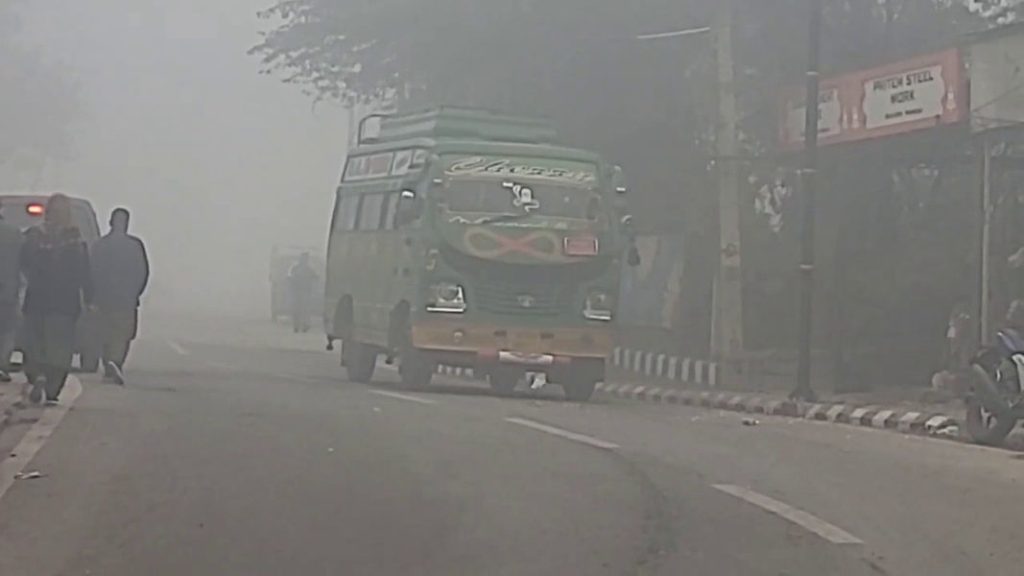Dense fog envelopes north India, parts of J&K, Himachal shiver in sub-zero temperatures
NEW DELHI: Dense fog shrouded several parts of north India on Friday, severely reducing visibility and affecting rail and air traffic. Minimum temperatures were mostly close to normal, but the mercury dropped below the freezing point in Kashmir and the hills of Himachal Pradesh.

Foggy conditions were reported from isolated pockets in Odisha and Bihar as well, with visibility in parts of Rourkela, Gaya and Patna reducing to nearly 50 metres, according to the India Meteorological Department (IMD).
There was dense fog in parts of Jammu and Kashmir, Punjab, Haryana, Uttar Pradesh and Rajasthan. A warning of heavy fog over the weekend was sounded in 30 districts of Uttar Pradesh and an advisory issued for motorists in Srinagar. Authorities in Srinagar said the foggy conditions were the “worst in recent memory”.
According to the IMD, “dense to very dense” fog conditions are very likely to continue from Friday night till Sunday morning in parts of Punjab, Haryana, Chandigarh, Delhi, Uttar Pradesh, north Rajasthan and Bihar.
Visibility improved in parts of Delhi on Friday, after two days of dense to very dense fog. The IMD said the improvement can be attributed to the breaking of the inversion layer in the morning, in contrast to the conditions observed from December 25 to 28.
Visibility was 200 metres at Safdarjung, Delhi’s main weather station, and 50 metres at Palam. Eleven Delhi-bound trains were delayed due to the fog, according to officials.
Amid disruptions in flight operations at the Delhi airport over the last couple of days, Civil Aviation Minister Jyotiraditya Scindia said the ministry is coordinating with airports and airlines, and putting in place measures to deal with the issue.
The fog issue is a “transitory phenomenon”, the minister told PTI, adding that the situation has been slightly unprecedented in terms of the density of fog this year.
Delhi’s maximum temperature settled at 19.8 degrees Celsius, a notch below the season’s average, and the minimum temperature at 10.7 degrees Celsius, four notches above normal. The Air Quality Index (AQI) at 4 pm was recorded at 382, which falls in the “very poor” category.
In Kashmir, which is currently in the grip of the 40-day harsh winter period of “Chilla-i-Kalan”, the temperatures dropped considerably.
The minimum temperature in Srinagar settled at minus 3.3 degrees Celsius. Visibility in Srinagar city and its adjoining areas was below 50 metres.
Pahalgam in south Kashmir’s Anantnag district recorded a minimum temperature of minus 5.4 degrees Celsius, the Gulmarg ski-resort in Baramulla minus 2.5 degrees Celsius, Qazigund minus 4.2 degrees Celsius, Kokernag town minus 2.6 degrees Celsius and Kupwara minus 4 degrees Celsius.
Ganderbal, Bandipora and Budgam recorded the lowest temperature of the season at minus 6.7 degrees Celsius each.
In Himachal Pradesh, the sky was partially overcast in the evening in Shimla and surrounding areas, while moderate to dense fog was recorded at some places in the lower hills.
The lower hills witnessed biting cold-wave conditions as the mercury hovered around the freezing point and Bhuntar recorded a minimum temperature of zero degree Celsius, followed by Mandi at 1.1 degrees Celsius, Sundernagar 1.2 degrees Celsius and Una and Narkanda at 2 degrees Celsius each.
The high-altitude tribal areas and other higher hills reeled under piercing cold-wave conditions, with the mercury settling 10 to 15 notches below the freezing point. Natural sources of water, such as lakes, springs, rivulets and tributaries, including a large stretch of the Chandrabhaga river, have frozen in the high-altitude tribal areas.
In Punjab and Haryana, parts of which were enveloped by a thick blanket of fog earlier in the day, the minimum temperatures mostly hovered close to the normal limits.
Chandigarh, the common capital of the two states, recorded a minimum temperature of 8 degrees Celsius.
In Punjab, Amritsar recorded a minimum temperature of 9.9 degrees Celsius, Ludhiana 9 degrees Celsius, Patiala 9.5 degrees Celsius, Pathankot 8.8 degrees Celsius and Faridkot 8.6 degrees Celsius.
In Haryana, the mercury settled at 9.8 degrees Celsius in Ambala, 8.2 degrees Celsius in Hisar, 9.4 degrees Celsius in Karnal, 9.6 degrees Celsius in Rohtak and 9.8 degrees Celsius in Sirsa.
Dense fog severely affected vehicular traffic in several parts of Rajasthan. Officials said Jaipur, Dausa, Alwar, Bharatpur, Dholpur, Karauli, Sawai Madhopur, Kota and Bundi, among other areas, reported reduced visibility.
State capital Jaipur recorded its lowest minimum temperature of the season so far at 8.4 degrees Celsius. The minimum temperature in hill station Mount Abu was 1.5 degrees Celsius.
According to weather officials, Fatehpur town in Sikar recorded a minimum temperature of 3.8 degrees Celsius, Sikar 6.5 degrees Celsius, Pilani 6.6 degrees Celsius, Churu 7.5 degrees Celsius, Alwar 8.4 degrees Celsius and Sangriya (Hanumangarh) and Bikaner 9.3 degrees Celsius each.
In Uttar Pradesh, Bijnor district’s Najibabad was recorded as the coldest place at a minimum temperature of 6 degrees Celsius. There was a significant decrease in the maximum temperatures in Ayodhya, Lucknow, Moradabad and Meerut divisions, according to the weather office.
Visibility dropped to around 40 metres at several places in the state due to dense fog. According to the IMD’s forecast, cold-day conditions are very likely in parts of Punjab, Haryana, Chandigarh, Delhi and isolated pockets of Uttar Pradesh during the weekend. (PTI)
